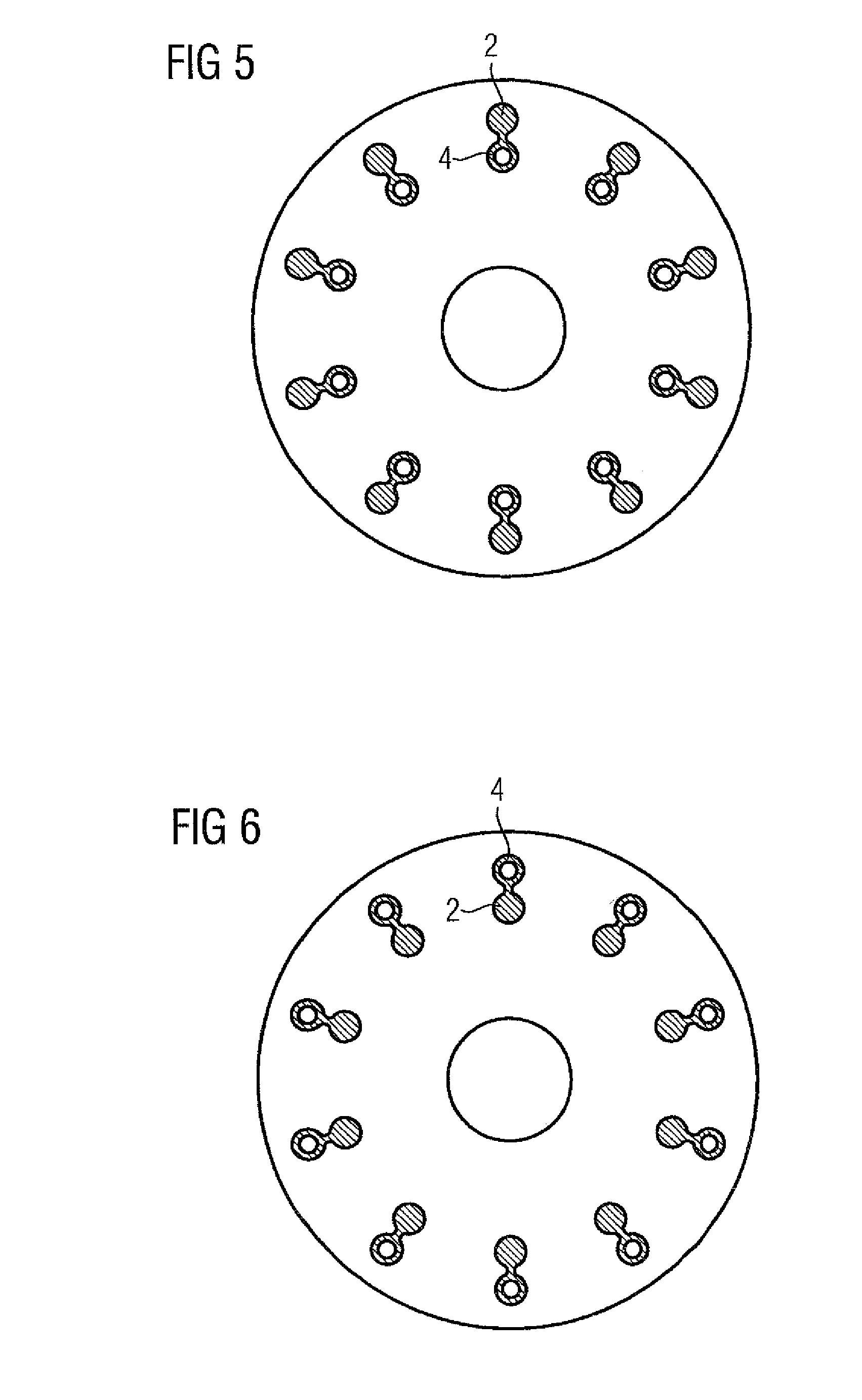Cooling system for an asynchronous rotor
a cooling system and asynchronous rotor technology, applied in the field of squirrel cage rotor, can solve the problems of reducing the effectiveness of such a cooling method, less effective blades on the shorting ring, and more difficult to remove heat from the rotating component such as the rotor, so as to achieve higher electrical resistance, higher electrical resistance of the starting bar, and higher electrical resistance
- Summary
- Abstract
- Description
- Claims
- Application Information
AI Technical Summary
Benefits of technology
Problems solved by technology
Method used
Image
Examples
first embodiment
[0036]FIG. 1 shows in cross-section a laminated rotor core 1 containing heat pipes 4. The laminated rotor core 1 is constructed of axially stacked electrical plates that are electrically insulated from one another. This construction reduces iron losses and eddy-current losses in the laminated rotor core 1.
[0037]In addition, the laminated rotor core 1 comprises first slots, in which shorting bars 2 are arranged. In order to achieve a maximum possible electrical efficiency, these shorting bars 2 are made of copper.
[0038]In addition, the laminated rotor core 1 comprises second slots in the form of axial holes, in which the heat pipes 4 are arranged. Viewed in the radial direction of the laminated rotor core 1, the heat pipes 4 and hence the second slots are located further inwards than the shorting bars 2 or the first slots.
[0039]In the manufacture of the squirrel cage rotor shown here, the shorting bars 2 and the heat pipes 4 are first inserted in the relevant slots. Then the laminate...
second embodiment
[0043]For example, FIG. 3 shows in cross-section a laminated rotor core 1 containing heat pipes 4. Like the embodiment of FIG. 1, first slots for holding shorting bars 2 are provided and second slots in the form of an axial hole for holding the heat pipes 4 are again provided here. In this embodiment, the second slots and hence the heat pipes 4 are arranged towards the outside viewed axially, i.e. in the vicinity of the outer sheath. The shorting bars 2, which are again made of copper in this case, are located towards the inside viewed in the radial direction of the rotor, i.e. nearer the rotor shaft. In this embodiment, the heat pipes 4, which are likewise made of copper, are used as starting bars for the asynchronous rotor. Their cross-sectional area is significantly less than that of the shorting bars 2. Hence the electrical resistance that the heat pipes present between the two shorting rings is significantly higher than that of the shorting bars 2.
[0044]Owing to the skin effect...
third embodiment
[0046]FIG. 5 shows a laminated rotor core containing heat pipes 4. In this case, both the heat pipes 4 and the shorting bars 2 are arranged in “double-bar slots”, i.e. in this arrangement the first slot, which is provided for the shorting bar 2, is connected via a thin connecting bridge to the second slot, which is provided for the heat pipe 4. The drawing shows a cross-section through the laminated rotor core and hence through the shorting bars 2 and the heat pipes 4. Viewed radially, the heat pipes 4 are arranged further inwards than the shorting bars 2. Such an arrangement makes sense particularly when the electrical resistance that the heat pipes 4 present between the two shorting rings is less than the electrical resistance that the shorting bars 2 present between the two shorting rings.
[0047]Normally, the cross-sectional area of the heat pipes 4 is less than that of the shorting bars 2, which are of solid construction. If, however, aluminum shorting bars, for instance made fro...
PUM
| Property | Measurement | Unit |
|---|---|---|
| electrically | aaaaa | aaaaa |
| electrical resistance | aaaaa | aaaaa |
| centrifugal force | aaaaa | aaaaa |
Abstract
Description
Claims
Application Information
 Login to View More
Login to View More - R&D
- Intellectual Property
- Life Sciences
- Materials
- Tech Scout
- Unparalleled Data Quality
- Higher Quality Content
- 60% Fewer Hallucinations
Browse by: Latest US Patents, China's latest patents, Technical Efficacy Thesaurus, Application Domain, Technology Topic, Popular Technical Reports.
© 2025 PatSnap. All rights reserved.Legal|Privacy policy|Modern Slavery Act Transparency Statement|Sitemap|About US| Contact US: help@patsnap.com



